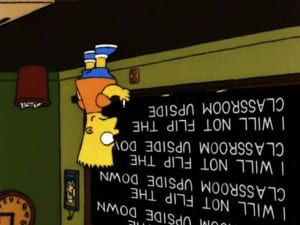 Time for renewed interest in Academic Digital Literacies is nigh. The principles of flipped learning are one of the ten reports in the OU’s third edition of Innovating Pedagogy. Suddenly the flip is all the rage, It’s popping up in conferences and being talked about in high places. It’s too early to say if interest in the flipped classroom go the way of other initiatives – flip in and flip out – with the transmissive lecture remaining a key pillar of a higher education experience – but if not, then the VLE’s time might finally have arrived.
Time for renewed interest in Academic Digital Literacies is nigh. The principles of flipped learning are one of the ten reports in the OU’s third edition of Innovating Pedagogy. Suddenly the flip is all the rage, It’s popping up in conferences and being talked about in high places. It’s too early to say if interest in the flipped classroom go the way of other initiatives – flip in and flip out – with the transmissive lecture remaining a key pillar of a higher education experience – but if not, then the VLE’s time might finally have arrived.
Flipping learning involves releasing content prior to lectures. Reluctance to upload slides and notes before lectures still exists but the practice has been a recommendation for some time. Research shows it supports learning and fears of students not turning up can be allayed by keeping relevant content back for the face-to-face experience. The preferred medium for flipping is video; either recordings of lectures or alternative lecture-related resources with contact time being used for interactive discussion and group work.
There are a number of reasons why current interest in the flip might catch on:
- The ability to rewind and repeat: internationalisation is often cited but while this might be helpful for those with English as a second language, user controlled video is useful for all.
- Changes to the DSA: starting September 2015 this will require institutions to revisit the provision of teaching resources. Accessible text, image, audio and video, which can be customised to suit the user requirements, has long been a strength of digital materials. Flipped learning is an opportunity to revisit the design and delivery of online content and ensure inclusive practice guidelines are followed.
- The Single Equality Act: requires a proactive approach; no one should have to request content in an alternative format – it should be provided from the start.
- User generated content: increasing quality of video and audio recorded on handheld mobile devices, and presented via free video editing apps, supports low budget ‘good enough’ production. DIY multimedia has become a reality.
- Academic digital literacies: the learning curve is getting steeper for those still reluctant to engage in digital ways of working but institutional interest in flipped learning may well lead to recognition that the adoption academic digital literacies requires investment in CPD time and resources.
Closer to home, Lincoln is installing a streaming media server with a site-wide license for camtasia relay; software supporting screen capture and voice over. Editing functions are limited but you can top, tail and chop. A multimedia powerpoint has become perfectly possible with educational licenses for the full Camtasia Studio less than £100.
Lincoln also has Blackboard Collaborate with the ability to record live synchronous video teaching with an interactive whiteboard, sharing desktop and internet tour facilities. A webcam, microphone and speakers is enough to get you started.
Lastly, there is the new Inclusive Digital Educational Resources working party which I’m chairing; under the Learning Support and Environment Standing Group. The remit is to come up with a set of recommendations to feed back to the Education and Student Life Committee for ensuring the digital learning environment at Lincoln is a fully accessible digital university.
Flipping the classroom might well become e-learning for the 21st century university.